How to make a water filter with your own hands: an overview of popular homemade products
Purification of water with homemade filters is a standard measure for field and field conditions. After all, wearing huge bottles is unreasonable because of the incredible physical costs. In addition, this is irrational due to the almost universal location of the necessary liquid component of the earth's shell.
The liquid that people really need is everywhere, but its sanitary condition is not always compatible with consumption. But you can make a very effective water filter with your own hands even on a multi-day route, being far from settlements, with a minimum of improvised means.
We will introduce you to the most effective and easiest to implement devices for cleaning dirty water. Here you will find diagrams, recommendations and a detailed description of manufacturing technology. The material proposed for acquaintance is systematized, supplemented by visual illustrations and video instructions.
The content of the article:
Why purify water?
Now various household filters are included in the list of basic kitchen interior appliances. They will do just fine if you need to filter out a couple of liters of liquid. But when it comes to large volumes, handheld and household devices are useless and you have to look for a commensurate alternative.
A suspension of sand, fine clay particles, organics, waste products of all kinds of animals and microorganisms make water from open reservoirs categorically unsuitable for drinking. Likewise, the situation with wells.
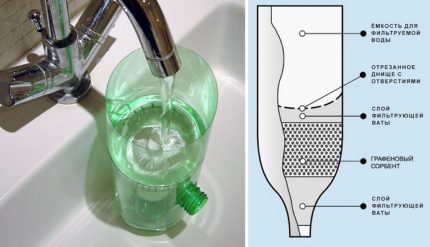
The agricultural industry annually becomes on a par with the heavy and chemical in terms of wrecking, due to the amount of nitrates used.So, the use of nitric acid to fertilize the soil, saturates groundwater with harmful salts.
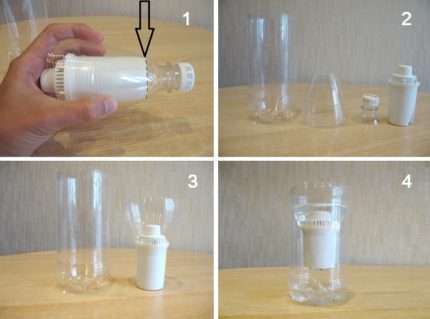
Be that as it may, even the most modern filtering equipment periodically needs to be replaced with cleaning cartridges, let alone self-made. After a certain time, it is necessary to replace the artisanal system with a specialized one.
This is important because water can contain pathogenic bacteria and other undesirable microflora, which is absolutely not amenable to filtration, and to cope with bacteriological pollution of a river or a well, only a sanitary epidemiological station is able to.
How to choose a filler for the filter?
Choosing a filter container, you need to calculate everything properly, because the cleaning properties first of all depend on a properly formed “filling”. By volume, the filter container must be such as to easily accommodate all components.
Natural materials, such as quartz river or washed quarry sand, gravel, activated carbon and zeolite, are widely used as absorbent. As you know, any filter begins with a primary layer of rough cleaning. Often this role is assigned to cotton-based fabrics.
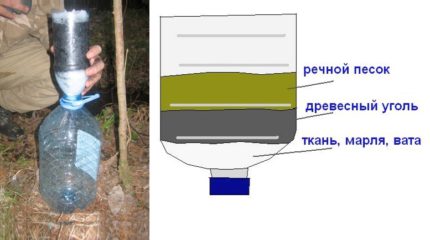
Natural materials are very impractical in terms of hygiene. Firstly, in a humid environment, such a filter layer is susceptible to decay processes, because of this an unpleasant odor appears. Secondly, the structure of the fabric involves a very rapid contamination of the filter with unwanted particles, which makes it necessary to change the layer.
Much better performance is observed with synthetic analogues. More preferred in this regard is lutrasil. The material has moisture resistant qualities and is more resistant to pollution than cotton or bandage.
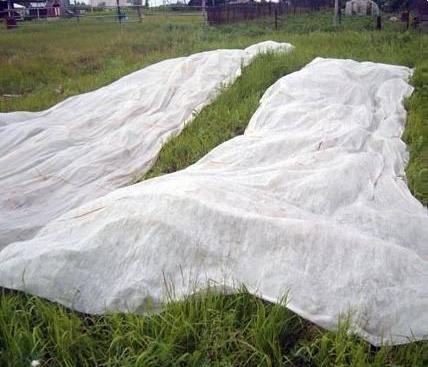
A completely budgetary option for a fabric filter is the synthetic layer used in making coffee.
Quartz sand copes with the delay of small particles, as well as the filtration of heavy chemical compounds.While gravel on the contrary, it is better to sift out large blotches of unwanted materials. An incomparable cleansing effect has a mineral called zeolite.
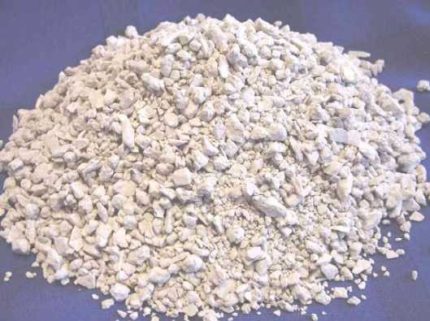
The active effect of the substance on cheers will cope with the pollution of water by metal and salt suspension, and also neutralizes pesticides and other products of the agricultural industry processing.
Activated Carbon Cleaning Devices
The most common group of homemade filters involves the use of activated carbon. The drug can be purchased at any pharmacy in unlimited quantities. Its stocks will practically not increase the weight of the luggage and will take up not so much space in the backpack.
But coal has few rivals in terms of cleaning power. It perfectly adsorbs toxic substances, absorbs an impressive number of heavy metals, mercilessly fights harmful microorganisms.
Small size hiking type
Perhaps the most high-quality filtration result is shown by home-made options based on activated carbon. The absorbent will equally well cope with the delay of both mineral formations and toxic substances.
The properties of the material include the ability to impart transparency to the liquid, as well as eliminate unpleasant odors and waste products of microorganisms.
When choosing coal, you need to pay attention to the structure of the mineral. Too small, powdery - will penetrate into the water, and large, on the contrary - will not provide the proper level of purification. (It is worth giving preference to the granular source material).
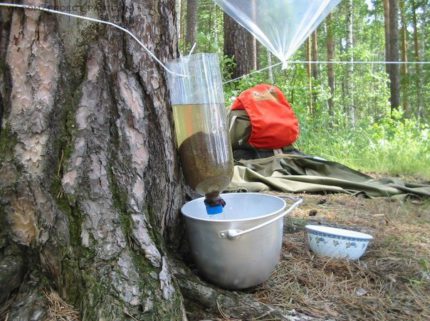
An important factor is the degree of so-called "roasting" of coal. If you overdo this procedure, the absorbent will quickly lose all its valuable qualities.
Coal can be bought at any supermarket, or made at home. The best absorbent qualities are observed in hardwoods, in particular birch.
It is not recommended to use conifers, since the essential oils contained in them can give a coniferous smell to filtered water.
To obtain coal, it is necessary to load the tree into any metal container and heat it over a fire (preferably put in the furnace). After the wood is heated to red, remove the container and let cool - that's all, charcoal is ready for use in the filtration system.
A very suitable option would be a homemade charcoal-based filter for water from the ash of a burned-out bonfire. On occasion, it is best to use whole pieces about 4 cm long.
As a rule, anything can serve as a body for such an impromptu system, but basically a plastic container or a bottle is used for convenience.
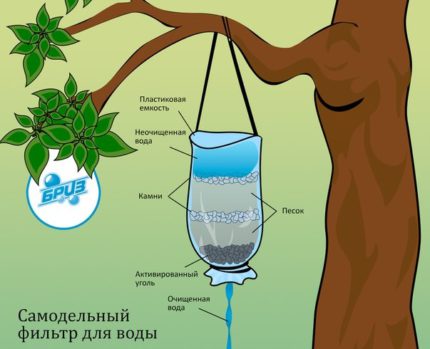
Making a carbon water purifier
Before assembling, you need to choose a more optimal version of the case.
To do this, you will need:
- Several plastic containers (bottles or PVC pipe, in some cases, food containers can be used. Due to their strength, they will serve well as the base of the cartridge).
- Tools for processing plastic (various sharp objects: awl, scissors, stationery knife, screwdriver).
- Absorbent material (in this case, activated carbon).
- Additional filtering granules (quartz sand, gravel).
- Material for the primary fabric filter (medical bandage, gauze or coffee filter).
- Plastic caps or caps.
For the tightness of the structure, at the joints of the modules, polymer substances should be used (if the filter is multi-level and consists of several parts). Moisture-resistant silicone glue or an insulating tape is well suited.
To install the suspension structure, you must first cut the bottom from the plastic bottle using a clerical knife. Then make two holes opposite each other for fastening the loops. Now an improvised body can be hung, for example, on a tree branch.
Next, you need to make an outlet valve, from where the filtered fluid will flow. At this stage, the design feature depends on individual preferences. You can organize something according to the principle of the shower - to make many small holes in the lid, or you can drill one big one.
The next step will be the direct installation of the components. Having twisted a perforated cover, the case is turned upside down or suspended by loops. Then, first of all, a bandage folded several times, or gauze, is laid. The use of a coffee filter is also welcome.
In some cases, you can find designs where the role of the primary filtering material is played by a fabric cover sewn specifically for the size of the housing. This greatly simplifies the task of changing the absorbent and saves time.
It is worth paying attention to the fact that the laying of absorbent components should be carried out as a “pyramid”. This means that the first thing that always follows is a fine-grained absorbent (coal), then comes a layer of quartz sand, and then comes the turn of river pebbles or gravel.
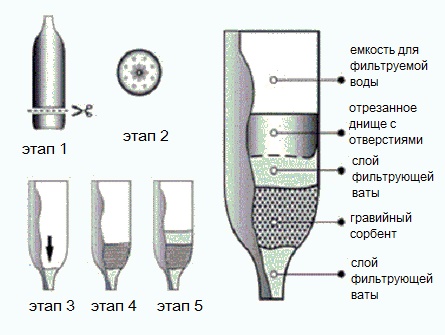
For greater efficiency, it is recommended to alternate several layers of pebbles, however, do not forget that excess material can interfere with the flow of water. It is better to cover the filling hole with some kind of cloth or a cover, in order to avoid getting unwanted objects inside the cartridge.
The principle of operation of such a filter is the passive flow of water through all layers.Under the action of granules, the contaminated liquid is cleaned and flows out of the perforated hole. Initially, several liters of water should be passed through the filter. The first filtering procedure will wash the layers and remove contaminants.
The disadvantages of the system include a rather slow cleaning rate and the need to constantly fill in a new liquid at the end of the filtration procedure.
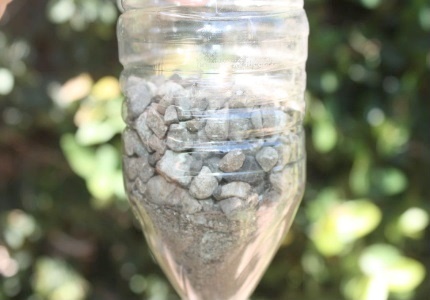
Useful homemade PVC pipe
To purify water in a suburban area, you can also make an effective purifier that can argue with factory products. It will be required for the treatment of water recruited in mine well or in water well, but it will be especially useful if water is scooped in the river, pond or lake.
For the construction of the structure, you will need a segment from the plastic water pipe and 2 containers. You can connect two bottles, where the upper segment will act as a coarse filter.
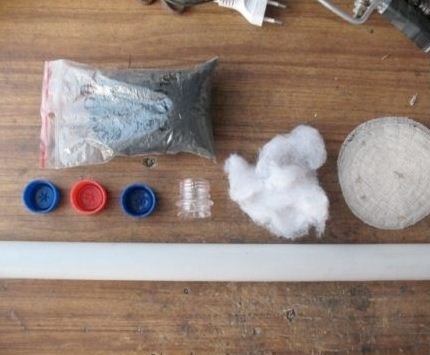
Inside it is supposed to be placed first a primary layer of gauze or cotton wool, while building some kind of mesh substrate, for example, plastic, so that the layers do not mix. A plastic cover that can be glued into a PVC pipe, then drill several holes of small diameter around the circumference is well suited for this.
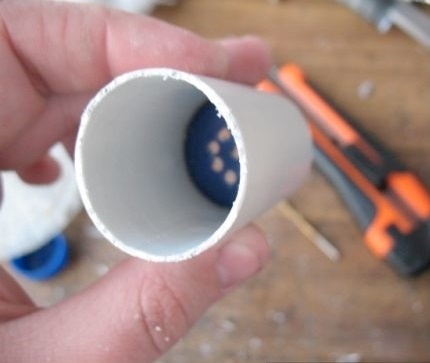
Next, the stage of filling the original cartridge with synthetic material begins (you can use a synthetic winterizer).
After that, close the module with a lid again, only this time you should not resort to the use of glue, because this part must be removable, in order to be able to replace and clean the filter material.
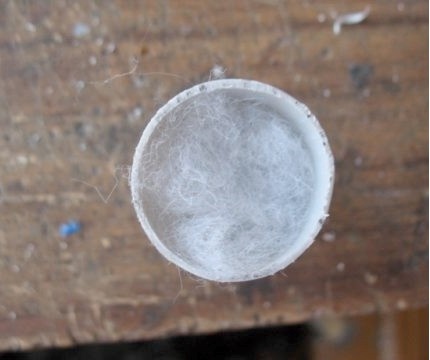
Then begins the turn of the plastic pipe. From the bottle you need to cut off the neck and fix it inside the pipe so that it is possible to use the thread.
It is worth tightening to prevent leaks (silicone glue is good). It is recommended to wrap the outer side and the edging of the neck with several layers of electrical tape for greater strength.
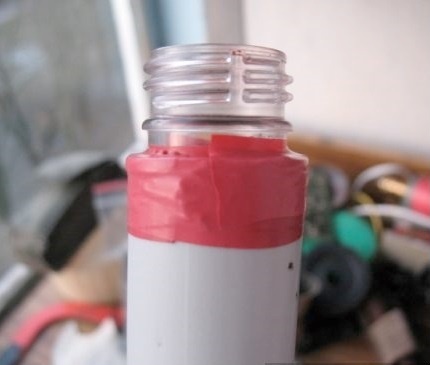
At the other end of the tube, as usual, you need to insert the lid and perforate. On the inner surface of the makeshift cartridge should be placed a fabric layer.
After all the manipulations, the structure is ready for filling with granulate (in this case, activated carbon). For better efficiency, you can alternate the layers of minerals inside the pipe.
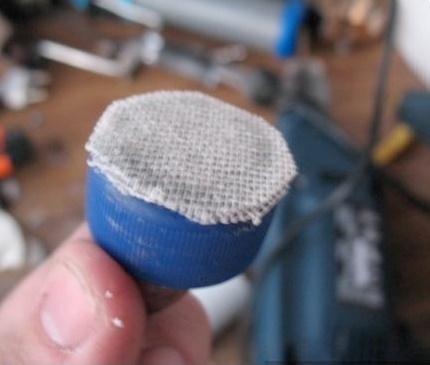
Upon completion, the primary filter and the carbon module are twisted together using a thread. Then, plastic bottles are added on both sides. That's it, the carbon filter made of PVC cut is ready to use.
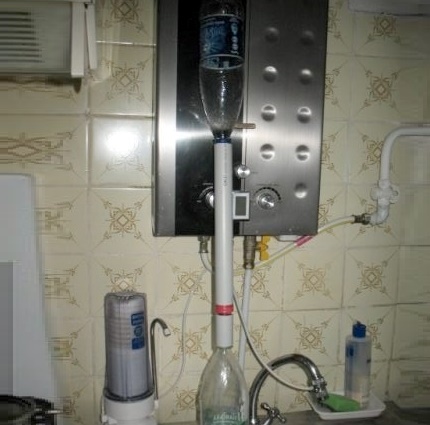
Aquarium water filter
As you know, for the normal functioning of aquatic inhabitants, it is necessary to clean the reservoir in a timely manner and maintain the purity of the water. Owners of small aquariums will come in very handy with instructions on how to build a filter at home.
Any plastic tube of suitable diameter can serve as the body of a home-made filter for treating hard water, including, for lack of such, 2 syringes are well suited.
Before assembly, you need to prepare some additional details: a spray bottle (often used in bottles with detergents), a sponge with a high degree of rigidity, as well as a mechanism by which the design will be attached to the aquarium wall (suction cup).
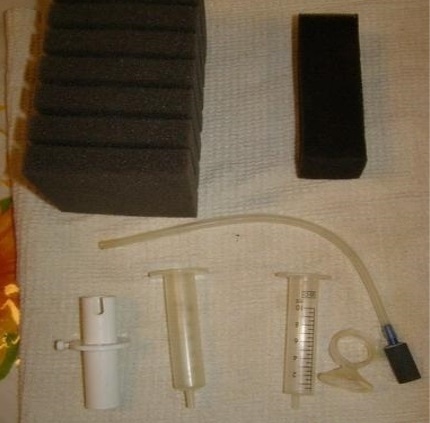
The first step is to remove the movable part of the syringe, it will not come in handy. Then, using hot-melt adhesive or another sealant, connect the workpieces to each other, after cutting off the nozzles.
Perforation is necessary for the flow of water. An ordinary soldering iron can do this perfectly, and if it is not there, you can heat any metal object, such as a nail, over the fire and make holes throughout the entire area of the syringe.

In some cases, some granulate can be poured into the filter capsule, the best option would be to use zeolite, because absorbent copes well with nitrate filtration. Next, inside the case you need to place the spray gun, while its flexible tube should evenly go along the entire length of the cartridge.
Then the impromptu cartridge should be completely wrapped with a sponge and the outer layer should be fixed so that it does not unwind. That's all, the power of such a filter is quite enough to purify water in a small aquarium.
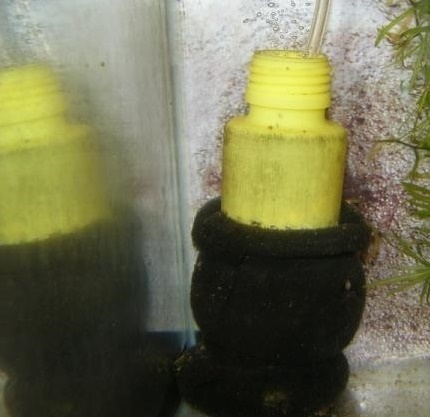
Sandy option for the pool
As already mentioned, the process of constructing small-sized variations of filter systems is quite simple, however, if we are talking about a large body of water, it is necessary to consider all the nuances of the purification system.
Many probably faced the problem of "flowering" of water. Most often, this process is observed in the warm season, and if private pool it is also equipped with a heating system, such an opportunity can happen anytime.
It is fair to say that the problem of green water can be completely solved by improvised means, namely, by mechanical removal, but sometimes a layer of algae can sink to the bottom and removal of the surface film will not solve the problem.
In addition, not only algae, but also fallen leaves, as well as sand and all kinds of microparticles, if the pool is on the street, can act as a pollutant.
Faced with problems of this kind, people begin to frantically buy all kinds of detergents and cleaning products, hoping to get rid of annoying green islands. But the active chemical action of substances can only help with a pollutant that is on the surface and in order to clean the tank to the very bottom, completely different methods are needed.
To completely clean the pool, there are special filter systems. They work on the principle of "vacuum cleaner", namely, they pump through the compressor liters of contaminated liquid. The filtration process is a multiple transfer of water from one part of the pool to another.
This mechanism is often used in large municipal or private institutions, where the pool sometimes reaches thousands of liters, so the best solution is an automated filtration system.
But it is not profitable for the average user to invest in such bulky equipment if, for example, it is necessary to clean only a small inflatable reservoir of a seasonal type.
Just for such reservoirs there is an instruction for the construction of a sand filter.
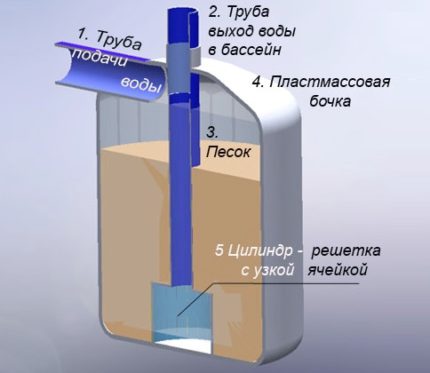
During the assembly process, you will need any capacity that can serve as a cartridge. The water tunnel from the primary filter can be made from a plastic pipe 2 meters long (in case the pool is large).
You also need to consider that the design of the tunnel involves a rotation of 90 degrees, so you need a PVC corner. The inner diameter of the cartridge and pipe should be about 50 mm.
A threaded sleeve with a diameter of M10 can be used as a support pin for cleaning modules. The convenience of this design allows you to connect multiple filter cassettes into one, which turns a conventional filter into a multi-level. This increases the efficiency of absorption and, as a result, the water becomes cleaner.
At the first stage, you need to make two holes (it is better to use a hammer drill).
The first is in the filter plug, and the second is in the PVC corner, then connect the two parts using a pin and a nut. A water compressor should be mounted at the other end of the tube. The power of the equipment should be selected based on the volume of the pool.
In order for the filter to be floating, it is necessary to make a special foam backing.
The purification process is circular, and occurs by means of water intake from the lower layers of the pool and pumping it through the filter using a pump.
The advantage of this design is the lack of additional elements for the release of filtered water, as well as the possibility of replacing the cartridge. The rinsing procedure is best carried out on a separate container to prevent dirty liquid from entering the pool. It is better to use a bucket for this.
In addition, the cost of this installation is much less than branded counterparts. Everything you need can be purchased at specialized retail outlets, for example, a compressor is sold in any pet store, PVC pipes and corners in building supermarkets, and a replacement cartridge in the markets in the plumbing department.
A big plus when creating a floating filtering system is the freedom of design thought. If you have decorative components at hand, you can mask the filter for any object that fits into the composition of the pool, for example, a ship.
Homemade Water Filter
At home, everyone can build a unit consisting of three containers connected in series. Such a water filter works only under a certain pressure of the water supply system.
As future cartridges, you can use plastic or glass containers, and you need to connect the segments by means of a transition nipple by ¼ inch.
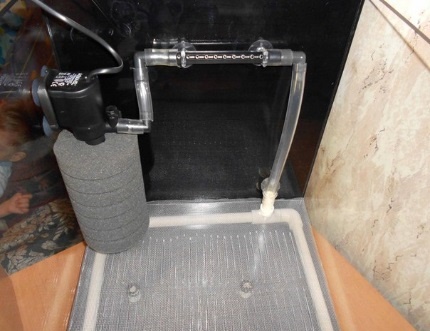
For convenience, input / output guides are applied to the adapters. They will make sure that the assembly process is successful. Another important point is the tightness of the installation. To avoid leaks, it is recommended that each thread be wrapped in Teflon tape, and the joints sealed with synthetic material.
A filter of such a sample is connected to a system like a tee and connected in series with water pipes. As the granulate, you can use all the same coal. It will clean raw water from harmful microparticles and prevent the appearance of scale on the heating elements of the electric kettle and washing machine.
Conclusions and useful video on the topic
After some time, you will have to replace the home-made system with a more professional one. This is due not only to the wear of old parts, but due to their low absorbent and cleaning efficiency with respect to microorganisms contained in water.
To ensure the sterility of the reservoir, modern filters are equipped with a mineralizing system. Before buying equipment, it is worth checking the water in the laboratory for the content of minerals and then, based on the results of the examination, select a filter with the appropriate mineral composition.
There is no such function in handicraft equipment, therefore it is recommended to boil the filtrate after the cleaning step. Also compare the power of the filter with the pressure of the water. Incorrect calculation of the water intensity in relation to a home-made filtration system can affect the performance of the equipment.
Video # 1. The process of manufacturing a simple filter from a plastic bottle:
Video # 2. For those who want to make a miniature version of a water filter, this video will help:
Video # 3. Construction of a filter for a personal reservoir:
There is really no limit to people's ingenuity, and this is clearly confirmed by the variations of the presented filters. A wide selection of materials, fillers and an abundance of forms are suitable for any occasion when you need to quickly purify water.
Want to share your own version of an effective homemade filter or ask a question? Please write comments in the block below the text of the article. Share useful information, ask questions, post a photo on the topic of the article.

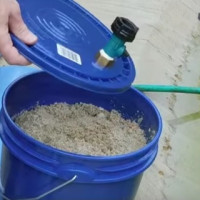 How to make a do-it-yourself sand filter for a pool: step-by-step instruction
How to make a do-it-yourself sand filter for a pool: step-by-step instruction 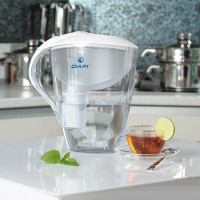 Water purification filter for a summer residence: selection tips + an overview of the best brands
Water purification filter for a summer residence: selection tips + an overview of the best brands 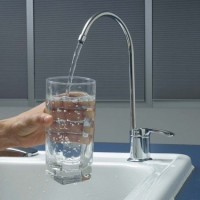 How to choose a filter for water: we figure out which filter is better + manufacturers rating
How to choose a filter for water: we figure out which filter is better + manufacturers rating 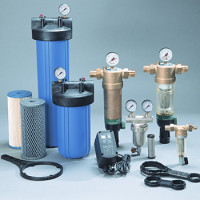 Filters for rough and fine water purification: overview of types + installation and connection rules
Filters for rough and fine water purification: overview of types + installation and connection rules  DIY reverse osmosis: step-by-step assembly and installation instructions
DIY reverse osmosis: step-by-step assembly and installation instructions  Types of water meters: overview of various types + recommendations for customers
Types of water meters: overview of various types + recommendations for customers  How much does it cost to connect gas to a private house: the price of organizing gas supply
How much does it cost to connect gas to a private house: the price of organizing gas supply  The best washing machines with dryer: model rating and customer tips
The best washing machines with dryer: model rating and customer tips  What is the color temperature of light and the nuances of choosing the temperature of the lamps to suit your needs
What is the color temperature of light and the nuances of choosing the temperature of the lamps to suit your needs  Replacement of a geyser in an apartment: replacement paperwork + basic norms and requirements
Replacement of a geyser in an apartment: replacement paperwork + basic norms and requirements
In the summer, we made a home-made filter in the country, used a five-liter bottle and charcoal (in charcoal bags), the water turned out perfectly clean and tasty. They even tried to filter the water from the lake, an excellent result. I think such a filter and on vacation is simply irreplaceable, though the design is not eternal and every time you need to re-craft, it would be a desire. You need to try one of the proposed methods in the article. I think the result will also be good.
Often there is not enough drinking water on the trip: you can’t get it as much as you need, you have to get out and “clean” the water yourself. Usually I prefer to make a construction of 5-liter bottles, I use charcoal as an absorbent, and I put a layer of moss on the prefilter. But if there is cotton wool with me, then I use it. He also made a filter for a summer residence; he made it from pipes, used a layer of coal and a layer of zeolite as filling.
I wouldn’t trust myself to make a filter for water purification, it’s better to buy some high-quality, already verified by someone in practice option in a normal store. Moreover, they are not so expensive. Another thing is if you understand this and are able to make a good filter yourself.There are no shops needed, and there is a good cost savings. But there are situations, for example, in a campaign when the use of home-made filtering devices is vital. However, you need to pass water through them several times and be sure to boil after processing.
In any case, a home-made filter will be inferior to a store filter due to a shorter resource and a shorter service life. They will come down as a temporary solution, but they can’t completely replace the factory filters.
Passing water several times through the same filter makes no sense. Passing through the upper coarse layers of the filter, the water will again become contaminated. You can make a cascade of filters in which the 2 and 3 filters of the cascade will not have coarse elements (stones, moss, upper fabric) at all, but will have a deeper layer of fine sand and coal. Sand purity also plays a role, if sand from the same river where water was taken, then obviously it needs to be cleaned separately. In general, imagination and engineering ingenuity help you!